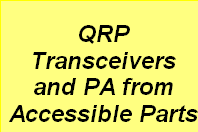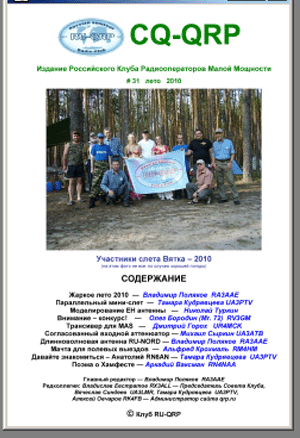

Antentop is FREE e-magazine devoted to Antennas and Amateur Radio an
Special page devoted to
Transceiver
Fetter - 80

Custom Search
|
ANTENTOP- 02- 2010, # 014 |
Transceiver Fetter - 80 |
|
|
|
||
|
|
|
|
|
|
Credit Line: CQ- QRP # 31 |
|
|
|
|
|
|
The transceiver is a practical implementation of the
theoretical schematic made by RA3AAE [References 1, 2]. Transceiver was made on a piece
of PCB of suitable sizes. Transceiver was made on 80- m band however,
this one may be tuned to another ham band. Figure 1 shows schematic of the transceiver. The
transceiver took part at MAS contest [References 3, 4], so parts at the
schematic labelled according to MAS rules. According to the MAS
rules the transceiver has only 36 components and it belongs to
category "A36." Data: Supply Voltage:
DC,
10.0... 14.0- V Consumer Current RX/TX (at 12.0- V): 15.0... 20.0-
mA/ 0.5- 0.7- A Sensitivity (at 10- dB S/N): near 10.0- microV Output power (at Dummy Load 50- Ohm): near
3.0- |
Cover:
CQ- QRP # 31 |
|
|
From
the mixer audio signal goes to Audio Filter L4, C11, C12 AND THEN
TO Audio Amplifier on VT6, VT7. Transformer T3 does matching of
impedance of the 32-Ohms headphones with the Audio Amplifier. TX mode: Key S1 is down at TX mode. Switch on VT4
provides DC ground for VT3, VT5. These transistors now are working
like doubler/amplifier. RF for the 80-meter band goes to the
antenna WA1 through low- pass filter L2, L3, C3, C6, C8, C9. The filter
should be tuned with a real antenna to match output impedance
of the amplifier with the antenna. Figure 2 shows PCB of the FETter.
VFO was made on the another board. Coils L2, L3 may be wounded on a form not less the
6-mm in diameter. Numbers of turn depend on used antenna. As coil
L1 should be used any stable- made inductor, for example, coiled
on a ceramic form from an old military radio. Transformers T2
and T3 coiled by trifiliar twisted wire,
8 turns. It was used insulated wire from a computer network cable.
Core for T2 and T3 is ferrite ring permeability 1000 with OD-
20, ID- 10 and H- 5-mm. |
Transformer T3 is from an old transistor radio. The
transceiver should be powered from a battery to avoid hum. Tuning: Audio Amplifier is
adjusted by R7 to half of the supply voltage on the collector
of VT7. VFO is tuned to the frequency half of the working
one. Pick to Pick RF voltage across the ground and the gate of
VT3 (VT5) should be 4... 5- V. Filter L2, L3, C3, C6, C8, C9 is tuned
(by its L and C) to the maximum of RF across the real antenna
(or across the dummy load). Figure
3 shows output RF from the transceiver at The transceiver was tested at MAS- 2010 contest. It
was made 3 QSO with other contesters: UU7JF, RW3AI and UA9FAX
(distance more the 1,500.0- km). |
|
|
Page-74 |
||
 |
 |
 |
 |
Just for Fun:

Powered byIP2Location.com
Thanks for your time!
Last Updated:
January 21, 2020 22:06





